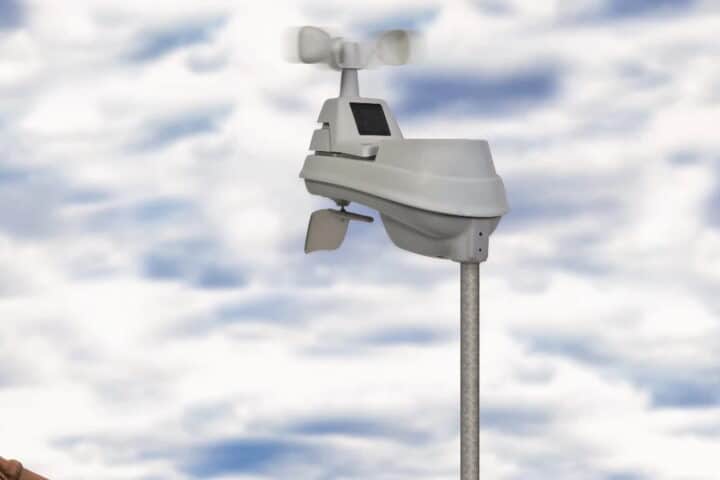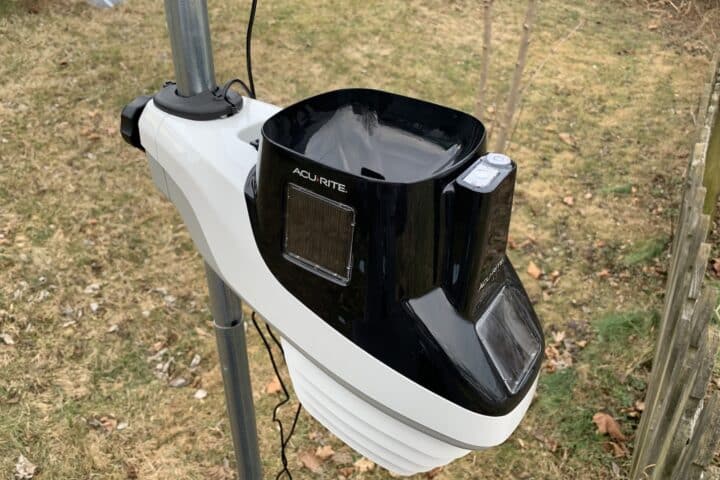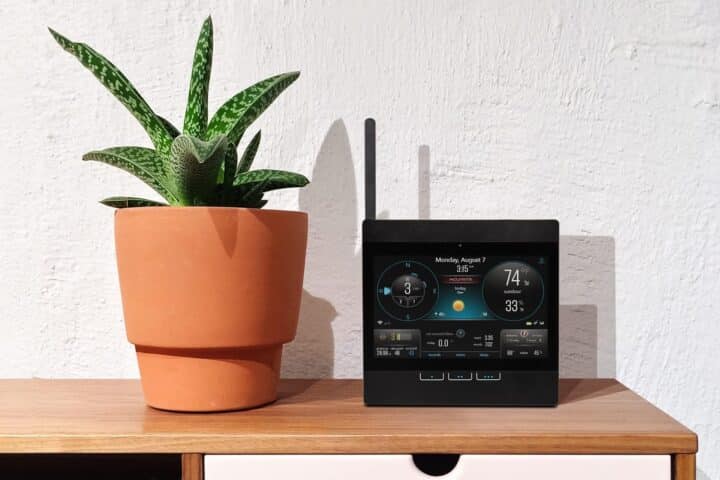AcuRite is likely one of the world’s most prolific weather instrument manufacturers. Chances are you’ve seen at least one AcuRite weather station at your local retailer: Walmart, Target, and Home Depot sometimes sell the AcuRite 3-in-1 or Acurite 5-in-1 weather stations (or both) in their brick-and-mortar stores.
But as you may have already read in our weather station guide, we don’t recommend purchasing these, as they are often cheaply made and have a poor reliability record. Yes, that includes some AcuRite models.
To answer this, AcuRite introduced the Atlas (our top pick), a higher-end station, and has often been rumored to be working on the Atlas Elite. These models are a step up from previous models. We’re also big fans of their app, which is arguably one of the best weather apps on the market.
AcuRite Weather Station Comparison
Below, we’ve laid out the specifications for the Notos, Iris, and Atlas weather stations. Remember, the Notos is the new name for the 3-in-1, and Iris is the new name for the 5-in-1. The Iris and Atlas include a solar panel on the sensor suite to increase sensor battery life.
AcuRite Notos vs Iris
In this comparison, the Iris is the better of the two AcuRite home weather stations. The Notos is little more than a glorified digital thermometer. However, its price makes it an attractive alternative to the more expensive stations.
If you’re okay with losing rainfall and wind direction and don’t have a lot of space to spare, opt for the Notos. However, if you can afford it, opt for the Iris instead; we think you’ll be happier overall.
AcuRite Iris vs Atlas
Whether you select the Iris or the higher-end Atlas depends on your budget. Both support the Access base station, which connects to the Internet to share weather data, which the Notos do not. They also support the most common weather measurements on any good station.
Overall, the Atlas instrumentation is of higher quality, thanks to an included daytime aspirating fan in the sensor housing. In our tests, this made the Atlas more accurate than even the Davis Vantage Vue in temperature and humidity readings. Atlas is it if you’re looking for better accuracy at a price significantly lower than other stations.
AcuRite Atlas vs Atlas Elite
It’s tough for us to truly judge how much better the AcuRite Atlas Elite is because it’s yet to be released. But we’d guess many of the Atlas issues would be corrected. With our Atlas, the lightning detection wasn’t as precise as we would have liked, and the rain gauge significantly undercounted rainfall.
AcuRite promises professional-grade instrumentation for the Atlas Elite, so we’ll have to wait and see.
AcuRite vs Ambient Weather
Both AcuRite and Ambient Weather excel at making affordable weather stations, but we prefer Ambient Weather’s weather stations for their accuracy. The Ambient Weather WS-5000 is far more expensive than the AcuRite Atlas. However, it’s a much more accurate weather station. Similarly, the Ambient Weather WS-2902 is competitively priced with the AcuRite Iris but is generally more accurate.
Our Test Results for AcuRite Weather Stations
AcuRite Iris

| Accuracy (25%) | Value (25%) | Durability (20%) | Feature Set (20%) | Ease of Use (20%) | Total Score |
|---|---|---|---|---|---|
| 3.5/5 | 4.5/5 | 4/5 | 3/5 | 5/5 | 80/100 |
MSRP: ~$150
Last year’s score: 75 (+5)
You might wonder why we rank the Iris ahead of the Atlas, but let’s explain. The Iris is an easy-to-use weather station with average durability and generally a good overall value. However, every AcuRite model seems to have something it doesn’t do well, and with the Iris that’s wind readings. The score change here was due to an adjustment upward in the accuracy rating (3 to 3.5) based on more data.
AcuRite Atlas

| Accuracy (25%) | Value (25%) | Durability (20%) | Feature Set (20%) | Ease of Use (20%) | Total Score |
|---|---|---|---|---|---|
| 3.5/5 | 4/5 | 4/5 | 4/5 | 5/5 | 78/100 |
MSRP: $269.99
Last year’s score: 78 (+0)
You’d think the Atlas would do better as a “higher-end” station. However, the rain gauge here is horribly inaccurate, and early models suffered from interference, making the optional lightning detector useless. While the latter was fixed in a recall of affected units, the rain gauge issue appears to be a design flaw.
AcuRite’s failure to produce a true pro-grade station may have been the reason why the Atlas Elite never saw the light of day, which was intended to compete with the Vantage Pro2. A shame, because the My AcuRite app is one of our favorites.
Popular Weather Station Mounting Options
Wrapping Up
As we said previously, we strongly recommend not purchasing AcuRite products from a retailer. These are lower-quality models than what you see above. Instead, stick with the recommended packages above to get the best value for your money.










